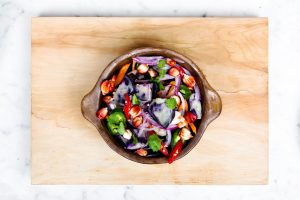 Why your plate should be a spectrum of rich and varied hues:
Why your plate should be a spectrum of rich and varied hues:
Excerpt from an article by Wendy Schmid, Q by Equinox
We’re naturally drawn to colorful things. Shiny cars, vivid sunsets, the Pantone color of the year (cheers to Radiant Orchid for 2014). Nutrition pros recommend extending that shade appreciation to your diet as well, because one of the keys to a healthy plate is color.
The foods that do the most damage to our cells and long-term health—sugar, flour, and processed carbohydrates—are devoid of vivid color (artificial food coloring notwithstanding). But what does it mean to eat with the color spectrum in mind? Terry Wahls, M.D., founder of the Wahls Foundation advises us to consume this breakdown: 3 cups cooked or raw greens, 3 cups of sulfur-rich veggies (cruciferous types like broccoli and cabbage), and 3 cups of vibrant-and-varied veggies (think orange, red, yellow). “I’m a big believer in variety, so if you can, try to hit all the colors each day,” she says. If that sounds like a tall order, start by decorating your plate with the most vivid hues in the produce aisle. It’s easier than you think to blend several colors into sautés and salads, or to make a colorful slaw by mixing purple and green cabbage plus carrots. This will help you steer clear of common deficiencies as you benefit your cells and boost eye, prostate, and vascular health.
The Color Orange
The Picks: Sweet potatoes, yams, winter squash, carrots, pumpkin, persimmons, apricots, turmeric root
The Payoffs: High in vitamin A, orange-hued eats improve immune and reproductive health; they also have anti-cancer and anti-bacterial properties.
The Color Yellow
The Picks: Acorn squash, crookneck squash, butternut squash, potatoes, bell peppers, apples, Asian pears, ginger root
The Payoff: Among other benefits, yellow produce promotes better eye and skin health and improved cognition.
The Color Green
The Picks: Asparagus, kale, spinach, dandelion greens, mustard greens, beet greens, broccoli, cabbage
The Payoff: Greens translate to a lowered cancer risk, improved eye health, and stronger muscles, teeth and bones.
The Color Blue/Purple
The Picks: Eggplant, purple cabbage, purple kale, purple cauliflower, purple potatoes, purple carrots, prunes, raisins
The Payoff: These deep, dark choices protect cells from damage and stave off cancer, heart disease, and have anti-aging, brain-boosting properties.
The Color Red
The Picks: Cranberries, bell peppers, radish, tomatoes, apples, cherries, pomegranates, raspberries, aronia berries
The Payoff: Red fruits and veggies contain antioxidants that contribute to heart health and also help prevent certain cancers; the lycopene in tomatoes has been linked to prostate cancer prevention, specifically.
Contributor: Dr. Gregg Baron
The statements made in this article have not been evaluated by Health Canada or the U.S. Food and Drug Administration. None of the information presented is intended to diagnose, treat, cure or prevent disease.


